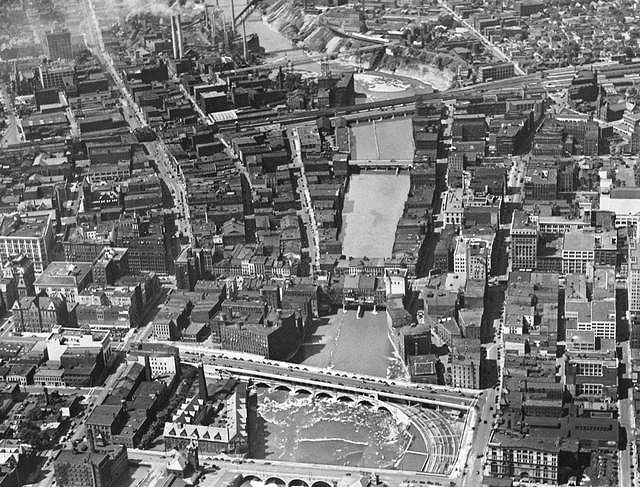This article was scraped from Rochester Subway. This is a blog about Rochester history and urbanism has not been published since 2017. The current owners are now publishing link spam which made me want to preserve this history.. The original article was published January 29, 2013 and can be found here.
![Aerial view of the Main Street bridge. 1929. [IMAGE: Rochester Municipal Archives]](https://senseofplace.dev/content/images/photos/aerial-main-street-bridge-rochester-1929.jpg)
The following is a guest post submitted by Matthew Denker .
Submit your story today .
Welcome to the first post in what will be an ongoing series called Filling In . One of the key elements of any great city is a tightly knit urban fabric. Whether you're in New York City, San Francisco, or our own beloved Rochester, building an appealing city scape at a human, walkable scale promotes health, wealth, and wisdom. We've also learned that parks next to parks next to barren windswept plazas don't put butts in seats, as they say. With that in mind, Filling In aims to explore vacant or underutilized pieces of Rochester in an effort to rebuild or strengthen our built environment. The aerial photo above was taken in 1929, when downtown was dense and energetic. And here is a reminder of what we're up against...
![Aerial view of downtown Rochester parking lots. [IMAGE: Google Maps]](https://senseofplace.dev/content/images/photos/filling-in-18exchange-01.jpg)
Looks like an excellent place if you're a car. If you're reading this though, you're probably not. Let's make it a better place for people.
This week we'll look at 18-26 Exchange Blvd. Currently the site of a tiny Chinese restaurant

that would fit easily into our new development and temporary day time storage for about 56 cars.
![Aerial view of 18-26 Exchange Blvd. [IMAGE: Google Maps]](https://senseofplace.dev/content/images/photos/filling-in-18exchange-02.jpg)
There's so many spots downtown begging for something, it was hard to pick just one. This lot is particularly bothersome, though, because it's surrounded by other successes. It's the last hole on a block that has seen a serious resurgence. Since there aren't many blocks downtown missing only one thing, this is a good place to start.
![18-26 Exchange Blvd. at street level. [IMAGE: Google Maps]](https://senseofplace.dev/content/images/photos/filling-in-18exchange-03.jpg)
This column will generally include a massing diagram for a potential site, a rendering of a similar development elsewhere, and a short description of the site's programming.
Let's start by looking at a massing diagram for a residential tower with retail on the first floor.
![Massing diagram for future development at 18-26 Exchange Blvd. [IMAGE: Matthew Denker]](https://senseofplace.dev/content/images/photos/filling-in-18exchange-04.jpg)
For 24 Exchange (2-4-X for marketing purposes!), the design is for an 8 to 9 story tower on top of a 20' single story podium. This offers an unbroken street wall on Exchange (the street shown in the massing diagram), for a good pedestrian experience. It also creates private outdoor space for each of the apartments on the second floor.
Each full L-shaped floor will have 7 apartments, all facing west or south. The east and north interior faces will be windows, but will be the hallways for resident access. The 10th floor will contain two larger apartments, and the roof of the east wing will be common outdoor space for all 58 apartments. The interior portions of the podium offer opportunities for resident amenities, such as a gym, a party room, and a library.
The whole building will be approximately 60,000 square feet. I would expect the units to be rentals, but the layout lends itself to a combination of rentals and condos if the market supported it at the time.
![A similar residential building in Madison, WI. [IMAGE: Gary Brink & Associates]](https://senseofplace.dev/content/images/photos/filling-in-18exchange-05.jpg)
From an exterior perspective, this building offers an excellent opportunity for an envelope to transition from masonry to glass. This will allow the building to connect and fit in nicely with its neighbors. The interior facade should be lightly colored to reflect more light back on the interior of the block. For example finishes and size, 24X would compare to this student housing being built in Madison, WI.
Come back next week when we explore another underutilized space in our great city.
* * *
About Matthew Denker:
Matthew Denker is a Project Director by day and a fantasy real estate tycoon by night. He has a deep interest in Rochester, NY, as well as the subjects of new urbanism, walkability, mass transit, and land use. Going forward he hopes to combine all of those things to make Rochester a city competitive not only with other small, successful cities, such as Portland and Minneapolis, but even better by leveraging its easy access to the world-class cities of Toronto and New York.


